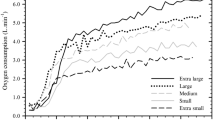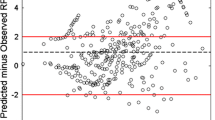Summary
Several types of work tasks are used to assess maximal aerobic power (MAP) in humans. Although it is well established that these work tasks may yield different absolute MAP values, little is known about the extent of the specificity of each MAP work task. 30 moderately active young men were tested at random for MAP with five commonly used work tasks: cycling supine, cycling sitting, alternate arm cranking standing, walking on a treadmill, and stepping on a bench. Statistical analyses show that these five tests do not give equal MAP means, equal variances or equal covariances. Various correlation techniques indicate, furthermore, that the common variance between the five aerobic power measurements is at best moderate. It was estimated that the overall common variance for Max ml O2·kg−1·min−1 reached about 50% of the total variance. The most efficient linear loading of each test in the first principal component could account only for 75% of the observed variance in MAP. It is concluded that these five work tasks do not yield parallel test forms, that the practice of transforming one MAP value into another should be abandoned, and that the practice of generalizing from one MAP value to a theoretical general MAP of the human body is not justified.
Similar content being viewed by others
References
Astrand, P. O., Saltin, B.: Maximal oxygen uptake and heart rate in various types of muscular activity. J. Appl. Physiol. 16, 977–981 (1961)
Astrand, P. O., Rodahl, K.: Textbook of work physiology. New York: McGraw-Hill 1970
Balke, B., Ware, R. W.: An experimental study of physical fitness of Air Force personnel. U.S. Armed Forces Med. J. 10, 675–688 (1959)
Barclay, J. K., Stainsby, W. N.: The role of blood flow in limiting maximal metabolic rate in muscle. Med. Sci. Sports 7, 116–119 (1975)
Bar-Or, O., Zwiren, L. D.: Maximal oxygen consumption test during arm exercise-reliability and validity. J. Appl. Physiol. 38, 424–426 (1975)
Bergh, U., Kanstrup, I.-L., Ekblom, P.: Maximal oxygen uptake during exercise with various combinations of arm and leg work. J. Appl. Physiol. 41, 191–196 (1976)
Bobbert, A. C.: Physiological comparison of three types of ergometry. J. Appl. Physiol. 15, 1007–1014 (1960)
Bottin, R., Petit, J. M., Deroanne, R., Pirnay, F., Juchmes, J.: Mesures comparées de la consommation d'O2 par paliers de 1 ou 2 minutes. Int. Z. Angew. Physiol. 29, 11–17 (1970)
Bouchard, C., Carrier, R., Boulay, M., Thibault-Poirier, M. C., Dulac, S.: Le développement du système de transport de l'oxygène chez les jeunes adultes. Québec: Editions du Pélican 1975
Clausen, J. P., Trap-Jensen, J., Lassen, N. A.: The effects of training on the heart rate during arm and leg exercise. Scand. J. Clin. Lab. Invest. 26, 295–301 (1970)
Cunningham, D. A., Goode, P. B., Critz, J. B.: Cardiorespiratory response to exercise on a rowing and bicycle ergometer. Med. Sci. Sports 7, 37–43 (1975)
Davies, C. T. M., Sargeant, A. J.: Indirect determination of maximal aerobic power output during work with one or two limbs. Eur. J. Appl. Physiol. 32, 207–215 (1974)
Davies, C. T. M., Sargeant, A. J.: Effects of training on the physiological responses to one- and two-leg work. J. Appl. Physiol. 38, 377–381 (1975)
Faulkner, J. A., Roberts, D. E., Elk, R. L., Conway, J.: Cardiovascular responses to submaximum and maximum effort cycling and running. J. Appl. Physiol. 30, 457–461 (1971)
Froelicher, V. F., Jr., Brammell, H., Davis, G., Noguera, I., Stewart, A., Lancaster, M. C.: A comparison of three maximal treadmill exercise protocols. J. Appl. Physiol. 36, 720–725 (1974)
Glassford, R. G., Baycroft, G. H. Y., Sedgwick, A. W., Macnab, R. B. J.: Comparison of maximal oxygen uptake values determined by predicted and actual methods. J. Appl. Physiol. 20, 509–513 (1965)
Gleser, M. A., Horstman, D. H., Mello, R. P.: The effect on \(\dot V\)O2 max of adding arm work to maximal leg work. Med. Sci. Sports 6, 104–107 (1974)
Gulliksen, H.: Theory of mental tests, pp. 173–192. New York: Wiley 1950
Hermansen, L., Saltin, B.: Oxygen uptake during maximal treadmill and bicycle exercise. J. Appl. Physiol. 26, 31–37 (1969)
Hollmann, W., Heck, H., Schmücker, B., Stolte, A., Liesen, H., Fotescu, M. D., Mathur, D. N.: Vergleichende spiroergometrische Untersuchungen über den Effekt und die Aussagekraft von Laufband- und Fahrradergometerbelastungen. Sportarzt Sportmed. 6, 123 (1971)
Holloszy, J. O.: Biochemical adaptations to exercise: aerobic metabolism. In: Exercise and Sport Sciences Reviews, Vol. 1 (J. H. Wilmore ed.), pp. 45–71. New York: Academic Press 1973
Holloszy, J. O.: Adaptation of skeletal muscle to endurance exercise. Med. Sci. Sports 7, 155–164 (1975)
Kasch, F. W., Phillips, W. H., Ross, W. D., Carter, J. E. L., Boyer, J. L.: A comparison of maximal oxygen uptake by treadmill and step-test procedures. J. Appl. Physiol. 21, 1387–1388 (1966)
Magel, J. R., Faulkner, J. A.: Maximum oxygen uptake of college swimmers. J. Appl. Physiol. 22, 929–933 (1967)
McArdle, W. D., Katch, F. I., Pechar, G. S.: Comparison of continuous and discontinuous treadmill and bicycle tests for max \(\dot V\)O2. Med. Sci. Sports 5, 156–160 (1973)
Mellerowicz, H.: Ergometrie. Berlin: Urban & Schwarzenberg 1962
Nie, N. H., Hull, C. H., Jenkins, J. G., Steinbrenner, K., Bent, D. H.: Statistical package for the social sciences, 2nd ed. New York: McGraw-Hill 1975
Pechar, G. S., McArdle, W. D., Katch, F. I., Magel, J. R., Deluca, J.: Specificity of cardiorespiratory adaptation to bicycle and treadmill training. J. Appl. Physiol. 36, 753–756 (1974)
Reybrouck, T., Heigenhauser, G. F., Faulkner, J. A.: Limitations to maximum oxygen uptake in arm, leg, and combined arm-leg ergometry. J. Appl. Physiol. 38, 774–779 (1975)
Roberts, J. A., Alspaugh, J. W.: Specificity of training effects resulting from programs of treadmill running and bicycle ergometer riding. Med. Sci. Sports 4, 6–10 (1972)
Shephard, R. J.: The relative merits of the step test, bicycle ergometer, and treadmill in the assessment of cardio-respiratory fitness. Int. Z. Angew. Physiol. 23, 219–230 (1966)
Shephard, R. J.: The prediction of maximal oxygen consumption using a new progressive step test. Ergonomics 10, 1–15 (1967)
Stamford, B. A.: Maximal oxygen uptake during treadmill walking and running at various speeds. J. Appl. Physiol. 39, 386–389 (1975)
Stenberg, J., Astrand, P. O., Ekblom, B., Royce, J., Saltin, B.: Hemodynamic response to work with different muscle groups, sitting and supine. J. Appl. Physiol. 22, 61–70 (1967)
StrØmme, S. B., Ingjer, F., Meen, H. D.: Assessment of maximal aerobic power in specifically trained athletes. J. Appl. Physiol.: Respirat. Environ. Exercise Physiol. 42, 833–837 (1977)
Vokac, Z., Bell, H., Bautz-Holter, E., Rodahl, K.: Oxygen uptake/heart rate relationship in leg and arm exercise, sitting and standing, J. Appl. Physiol. 39, 54–59 (1975)
Wilks, S. S.: Sample criteria for testing equality of means, equality of variances, and equality of covariances in a normal multivariate distribution. Ann. Math. Stat. 17, 257–281 (1946)
Williams, C. G., Wyndham, C. H., Du Raan, A. J. N., Kok, R.: A comparison of the physical working capacity of individuals as determined by various tasks. Int. Z. Angew. Physiol. 24, 102–110 (1967)
Wyndham, C. H., Strydom, N. B., Leary, W. P., Williams, C. G.: Studies of the maximum capacity of men for physical effort. Part 1. A comparison of methods of assessing the maximum oxygen intake. Int. Z. Angew. Physiol. 22, 285–295 (1966)
Author information
Authors and Affiliations
Additional information
This work was supported by the Quebec Department of Education and by the Research grant program of Laval University
Rights and permissions
About this article
Cite this article
Bouchard, C., Godbout, P., Mondor, J.C. et al. Specificity of maximal aerobic power. Europ. J. Appl. Physiol. 40, 85–93 (1979). https://doi.org/10.1007/BF00421154
Accepted:
Issue Date:
DOI: https://doi.org/10.1007/BF00421154




